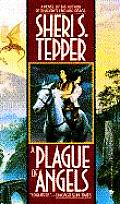
| Publisher: | Bantam |
| Copyright: | October 1993 |
| Printing: | December 1994 |
| ISBN: | 0-553-56873-6 |
| Format: | Mass market |
| Pages: | 559 |
Abasio is bored and unsatisfied with his life on a country farm and decides to run away for the excitement and variety of the city. On the way, he meets a man who is taking an infant to a nearby archetypical village, foreshadowing thick in the air. Elsewhere, in a dark fortress, an abused woman serves the "witch" Ellel, holding a book from which she reads to the inhuman monsters she has as servants.
At the start, A Plague of Angels looks like pure fantasy cliche, but Tepper doesn't wait long before starting to throw curveballs. Abasio is picked up by a trucker on the main road leading to the city, rather than by a wagon or passing mounted men, and the city is a wasteland of warring street gangs using modern weaponry and drugs. Ellel's servants are clearly technological, and while none of the characters recognize the signs, it's clear from early in the story that they're leaking fatal radiation (with a bit of handwaving — the amount of damage that radiation does is conveniently plot-driven). But the best twist in the early story is the archetypical village in which Orphan finds herself. Tepper plays with both the apparent cliche of the start and the fantasy genre in a village in which everyone is known by their role. The best part of the early book is Orphan's childhood in the village, adjusting to archetypes coming and leaving and slowly outgrowing her role as Orphan.
Unfortunately, that's about the only interesting part of the early book. We do get some tidbits about the Place of Power and the four families that rule it, but mostly we get Abasio in the city, which is a caricature of everything that can possibly be wrong with an inner-city gang culture. The city is divided into arbitrary color-based gang identities, veneral disease is rampant and the major killer in the city, women are treated as possessions and income sources, and there's constant low-intensity macho warfare between the gangs. The depravity is rather over the top and at times (such as the supposed degeneration of language) very unbelievable.
We get lots and lots of this. The book stays somewhat interesting thanks to the Ellel scenes, which add more technology and some mystery about what's really happening. It becomes increasingly clear that the world is post-apocalyptic after a sort (apparently most of the people have left for the stars), and Orphan acquires an intriguing prophecy. But there's just far too much of the cities and ganger life, none of which is particularly interesting, and I got thoroughly sick of it.
It finally becomes more clear why Ellel is after Orphan, Abasio leaves the city, and A Plague of Angels very slowly starts to go somewhere. There's a long and often boring travel section (livened somewhat by the introduction of a coyote) between the heroes and the Place of Power, so it's not perfect, but the tension and speed of revelation increases significantly after the middle of the book. It wouldn't surprise me if a lot of people gave up before then, though.
If you do get that far, the heart of the book is the last hundred pages and the climax in the Place of Power, where revelations and hard choices fly fast and furious, the book takes several unexpected turns, and the journey does become worth the reading time. I was hoping for something a bit more substantial than the ecological message that Tepper puts at the center of the book, but the way in which she gets there is satisfying and uncompromising. Orphan is an excellent character who builds in depth and character throughout. The final climax is a touch silly in places, but it builds naturally from the rest of the book and carries enough drama and momentum that it feels majestic and important nonetheless.
A Plague of Angels shares with Beauty, the only other Tepper novel that I've read, a tendency to sprawl. Tepper has many interesting ideas, but the way she populates the world with them feels unfocused. A Plague of Angels is a bit better in that it has a travelogue and alliance story underneath to try to tie together the monsters, animals, and different human groups, but it still lacks a tight focus on a central plot. It is also, characteristic for Tepper, rather preachy. The things Tepper doesn't like she really doesn't like, and therefore has a tendency to portray in one-sided, exaggerated ways. I think the city portions suffered from that the most; the Place of Power fares better, with the "Mitty" and "Berkli" families as amusing enough parodies that I didn't mind the cheap shots. Ellel turns into slightly less of a stereotype later in the book. But you have to be willing to swallow quite a lot of back-to-nature environmental idealism and anti-technological prejudice (except, of course, for the semi-magical "good" technology that exists without any industrial base).
The last bits of the book and the slow revealing of the secrets of the Place of Power and the meaning of the prophecy are excellent. The archetypical village is a great idea, which partly salvages the early book. I wish there was less book padded around those ideas; if there were, I could recommend A Plague of Angels more comfortably. As-is, it's interesting and unconventional, but flawed and sometimes painfully slow.
Reviewed: 2008-09-01